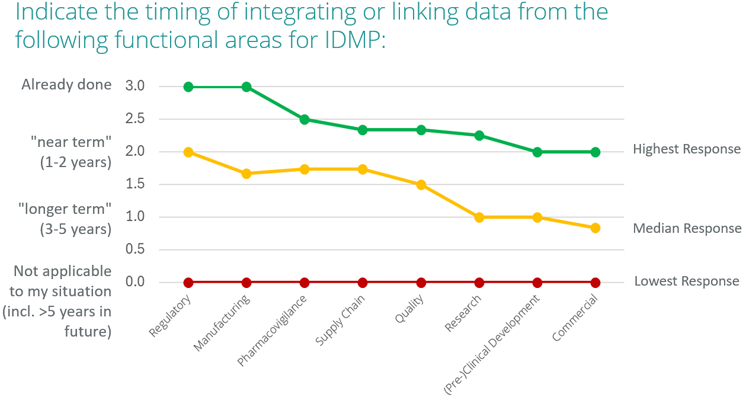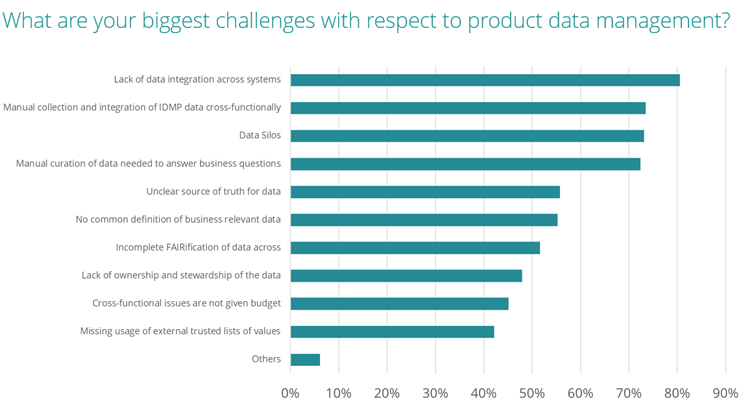Survey Findings: How Are IDMP Readiness Efforts Progressing?
By Michiel Stam, MAIN5

ISO Identification of Medicinal Products (IDMP) standards were designed to harmonize the way the life sciences industry records and manages data about its products. Although these standards have been more than a decade in the making, companies’ state of readiness to implement and harness IDMP still varies considerably. The same is true of their relative maturity in supporting FAIR data principles, geared to making data more Findable, Accessible, Interoperable, and Reusable. These are goals that are actively promoted by Pistoia Alliance, a nonprofit industry coalition working to lower barriers to innovation in life sciences and healthcare R&D through pre-competitive collaboration.
With renewed momentum around EMA’s IDMP implementation in Europe, FDA’s own related plans in the U.S., as well as cross-industry initiatives, MAIN5 recently partnered with Pistoia Alliance and data registry specialist Accurids to conduct new benchmark research1 to determine companies’ latest progress and planning around IDMP implementation.
Have Digitalization Ambitions Stalled?
Large pharma companies now generally have good awareness of the value of IDMP-based product data standardization as part of wider process digitalization ambitions, the survey confirmed. More than 70% of those surveyed identified IDMP’s value as an enabler of cross-functional data integration; only 11% saw compliance as the primary goal of IDMP projects.
Companies generally plan to integrate IDMP data from regulatory, manufacturing, pharmacovigilance, supply chain, and quality functions within the next three years. Research, preclinical, clinical, and commercial data integration will follow in the mid-term (within five years). This phased approach indicates that companies are initially prioritizing data that supports regulatory submissions and compliance, followed by broader data integration to support product development and commercial strategies to maximize the benefits of IDMP.

Figure 1. Courtesy of Accurids and MAIN5.
As things stand, however, product data management continues to pose a challenge for companies across the board. The benchmark study identified particular issues with manual data collection, data silos, and a lack of data integration across systems. An unclear source of truth and insufficient use of trusted external sources were also flagged as barriers to harnessing product data more strategically.
Figure 2. Courtesy of Accurids and MAIN5. Click on figure to enlarge.
Those actively striving toward more seamless data integration across and between functions felt that a lack of resources and issues with ownership were the main barriers to achieving this (indicated by 44% and 41% of respondents, respectively), beyond a current lack of data standardization (the main obstacle, cited by 56%). Surprisingly, the quality of data (and therefore its usefulness) was ranked below these factors (cited by 33%).
Master Data Alignment And IDMP-O
The Pistoia Alliance’s IDMP-Ontology (IDMP-O) project, launched in early 2024, aims to create a shared ontology (a representation of data properties and the relations between them) to encourage uniform adoption of the IDMP standards and, by extension, consistent information exchange. The IDMP-O can drive and facilitate master data management, automation, and AI — positively impacting analytics and ultimately reducing costs.
When survey respondents were asked if companies currently use IDMP as the master data model for their product information, many were unsure how well aligned their existing model is. Just 40% felt confident that they possess an IDMP-compatible model, although 75% use IDMP to guide product information. This is one of the gaps addressed by Pistoia Alliance’s IDMP-O project, in that it allows the exact measurement of how compatible existing data models and ambitions are with IDMP.
Promisingly, 43% of the large pharma companies taking part in the benchmark research expressed a willingness to take IDMP-O into production within their organizations within the first year of its release. (IDMP-O production release 1.0 was published in January 2024; version 1.3 is now live.) Although an encouraging observation, many of the organizations that participated in the survey are inherently closer to IDMP-O than others in the industry, so the finding may not be representative.
Respondents were then invited to express, in their own words, where they anticipated deriving the most value from IDMP-O. Their open-ended responses confirmed good awareness of the ontology’s strategic benefits, including the associated scope to enhance the integration and exchange of product data with regulators and industry partners, among other stakeholders.
Operationally, respondents recognized that the Pistoia Alliance ontology supports cross-functional alignment on data ownership, standardization of data definitions, and adoption of a shared data model to enable system interoperability and improve overall data quality. These factors pave the way for improved efficiencies in data management, decision-making, submissions, and compliance. There is still work to be done before companies can harness those benefits, however.
Reigniting IDMP Project Momentum
Where early enthusiasm around IDMP programs had waned in response to slow progress from EMA in Europe toward clarifying specific requirements, reigniting momentum behind IDMP-based projects should be a priority now, both among life sciences companies and the supporting vendor community.
A raft of recent developments will help companies define concrete next steps and avoid potential rework. These include the EMA’s go-live of the Product Lifecycle Management portal (with Product Management Services and electronic application forms), as well as improved clarity on implementing substance, product, organization, and referential (SPOR) services and integrating with EMA systems and processes. Certainly, for companies with larger product portfolios, advanced technological capabilities will be needed to efficiently prepare data in bulk for what could be thousands of registrations. Making manual updates per product by reentering data in the PMS system is not feasible.
Defining the right strategy, implementing supportive system capabilities, and recruiting and training a workforce to collect, transform, and submit data according to specific requirements is a significant undertaking that requires careful planning and execution.
The survey does suggest that many companies are now actively working toward enterprise-wide integration of data and IDMP-related processes. Harnessing Pistoia Alliance’s IDMP-Ontology offers them their best chance of cross-functional alignment on data ownership, standardization, and adoption of a common data model to enable interoperability and improvement of data quality in line with FAIR data principles.
Ultimately, robust IDMP compliance lays the foundation for a more interconnected and streamlined regulatory landscape, benefiting pharmaceutical companies, regulatory authorities, and patients worldwide. It is an opportunity to revolutionize how pharmaceutical data is managed and used toward a more sustainable future for healthcare.
The full report, Accelerating Digital Transformation in Pharma with IDMP: An industry benchmark report on the status of IDMP standards implementation in pharma and the role of the IDMP Ontology for accelerating digital transformation, is free to download here.
Reference
- The IDMP benchmark survey of 18 pharma companies was conducted in Q3 2024 by Pistoia Alliance, MAIN5, and Accurids, and supported by the IDMP-Ontology project with participants from AbbVie, Amgen, AstraZeneca, Boehringer Ingelheim, Bayer, and Novartis. Available here.
 About The Author:
About The Author:
Michiel Stam is a management consultant and senior regulatory expert at MAIN5 with 15 years of experience in regulatory information management (RIM) and IDMP. MAIN5 is a European consulting firm specializing in digitally enabled change for life sciences R&D organizations. He can be reached by email at michiel.stam@main5.de.

